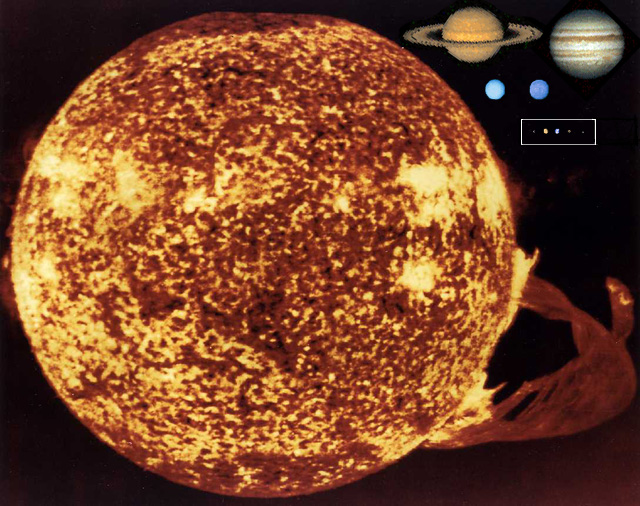
Much of what is known about the stars comes from studying the star closest to us, the Sun. At a distance of almost 150 million kilometers, the Sun is a few hundred thousand times closer to us than the next nearest star. Because of its proximity, astronomers are able to study our star in much, much greater detail than they can the other stars.
The Sun is a G2-type main sequence star that has been shining for almost 5 billion years. It is known from radioactive dating of the Earth, Moon, and meteorites, that these objects have been around for about that length of time and temperatures on the surface of the Earth have been pleasant since it formed. The Sun's energy has made this possible. What could power something as big as the Sun for so long? The process called nuclear fusion is now known to be the source of the Sun's enormous energy, as well as, other stars. This is a relatively recent discovery. However, using simple physical principles of gas physics, astronomers knew about the density and temperature structure of the interior of the stars long before they unlocked the secret to what could power them for so long. This chapter will cover these topics. I will first give a brief description of the Sun to give you an idea of what a star is like and then go into the basic principles of what the interiors of stars are like and what powers them. The vocabulary terms are in boldface.

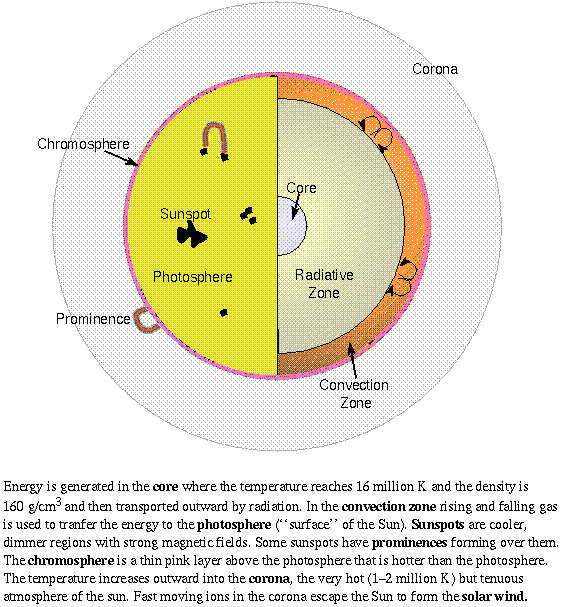
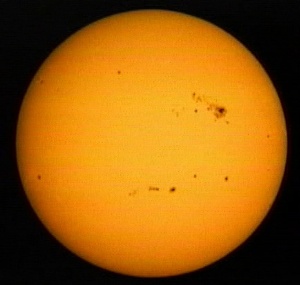 The deepest
layer of the Sun you can see is the photosphere. The word
``photosphere'' means ``light sphere''. It is called the ``surface'' of the
Sun because at the top of it, the photons are finally able to escape to space.
The photosphere is about 500 kilometers thick.
Remember that the Sun is totally gaseous, so the surface is not something you
could land or float on. It is a dense enough gas that you cannot
see through it. It emits a continuous spectrum. Several methods of measuring
the temperature all determine that the Sun's photosphere has a temperature of
about 5840 K.
The deepest
layer of the Sun you can see is the photosphere. The word
``photosphere'' means ``light sphere''. It is called the ``surface'' of the
Sun because at the top of it, the photons are finally able to escape to space.
The photosphere is about 500 kilometers thick.
Remember that the Sun is totally gaseous, so the surface is not something you
could land or float on. It is a dense enough gas that you cannot
see through it. It emits a continuous spectrum. Several methods of measuring
the temperature all determine that the Sun's photosphere has a temperature of
about 5840 K.
Another method uses the flux of energy reaching the Earth and the inverse square
law. Recall from the Stellar Properties
chapter that the flux is the amount of
energy passing through a unit area (e.g., 1 meter2) every second. From the
Inverse Square Law of Light Brightness, you find that the solar flux at
the Earth's distance = the Sun's surface flux × (Sun's radius/Earth's
distance)2 = 1380 Watts/meter2. Since
the Sun's photosphere is approximately a thermal radiator, the flux of energy at
its surface = ![]() × (the Sun's surface temperature)4,
where
× (the Sun's surface temperature)4,
where ![]() is the
Stefan-Boltzmann constant. Rearranging the equation, the photosphere's
temperature = [(solar flux at Earth)/
is the
Stefan-Boltzmann constant. Rearranging the equation, the photosphere's
temperature = [(solar flux at Earth)/![]() ) ×
(Earth distance/Sun's radius)2]1/4.
) ×
(Earth distance/Sun's radius)2]1/4.
These two methods give a rough temperature for the Sun of about 5800 K. The upper layers of the photosphere are cooler and less dense than the deeper layters, so you see absorption lines in the solar spectrum. Which element absorption lines are present and their strength depends sensitively on the temperature. You can use the absorption line strengths as an accurate temperature probe to measure a temperature of about 5840 K.
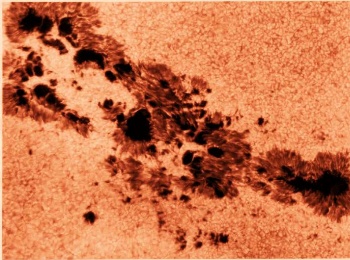
Galileo discovered that the Sun's surface is sprinkled with small dark regions called sunspots. Sunspots are cooler regions on the photosphere. Since they are 1000--1500 K cooler than the rest of the photosphere, they do not emit as much light and appear darker. They can last a few days to a few months. Galileo used the longer-lasting sunspots to map the rotation patterns of the Sun. Because the Sun is gaseous, not all parts of it rotate at the the same rate. The solar equator rotates once every 25 days, while regions at 30ƒ above and below the equator take 26.5 days to rotate and regions at 60ƒ from the equator take up to 30 days to rotate.
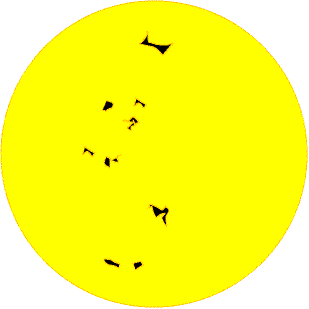
Hundreds of years of observing the sunspots on the Sun shows that the number of sunspots varies in a cycle with an average period of 11 years. At the start of a sunspot cycle the number of sunspots is at a minimum and most of them are at around 35ƒ from the solar equator. At solar maximum when the sunspot number peaks about 5.5 years later, most of the sunspots are within just 5ƒ of the solar equator.
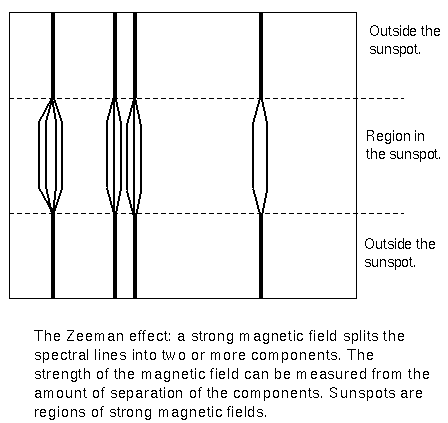
Sunspots are regions of strong magnetic fields. This affects the spectral lines in the sunspot spectra. Each absorption lines will split up into multiple components. The amount of separation between the components measures the strength of the magnetic field. The magnetic field is somehow responsible for the sunspot cycle. In one 11-year cycle the leading sunspot in a sunspot group will have a north magnetic pole while the trailing sunspot in the group will have a south magnetic pole. In the next 11-year cycle the poles will switch so the total cycle is 22 years long.
At solar maximum there are more prominences and solar flares. Prominences are bright clouds of gas forming above the sunspots that follow the magnetic field line loops. So-called ``quiet'' ones form in the corona (the Sun's atmosphere) about 40,000 kilometers above the surface. Sometimes they form loops of hydrogen gas as the gas follows the loops in the magnetic field. Quiet prominences last several days to several weeks. ``Surge'' prominences lasting up to a few hours shoot gas up to 300,000 kilometers above the photosphere.

Solar flares are eruptions more powerful than surge prominences (a flare is shown in the Sun + planets montage above). They will last only a few minutes to a few hours. A lot of ionized material is ejected in a flare. Unlike the material in prominences, the solar flare material moves with enough energy to escape the Sun's gravity. When this burst of ions reaches the Earth, it interferes with radio communication. Sometimes a solar flare will cause voltage pulses or surges in power and telephone lines. Brownouts or blackouts may result. Humans travelling outside the protection of the Earth's magnetic field will need to have shielding from the powerful ions in a flare.
High resolution observations of the solar surface show a honeycomb pattern called granulation made of bright spots of convection 700 to 1000 kilometers across (see the picture above). Hot gas rises in the middle of each granule bringing energy from the interior to the surface and sinks back down on the border of a granule. The hot gas rising in the center is brighter than the cooler gas sinking at the borders. Each granule will last for about 8 minutes.
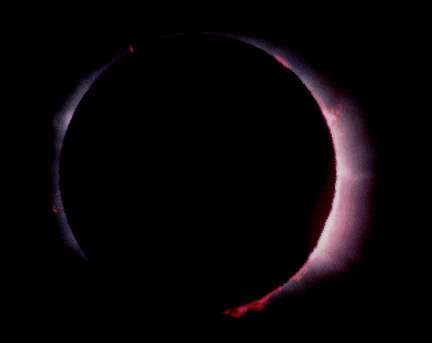
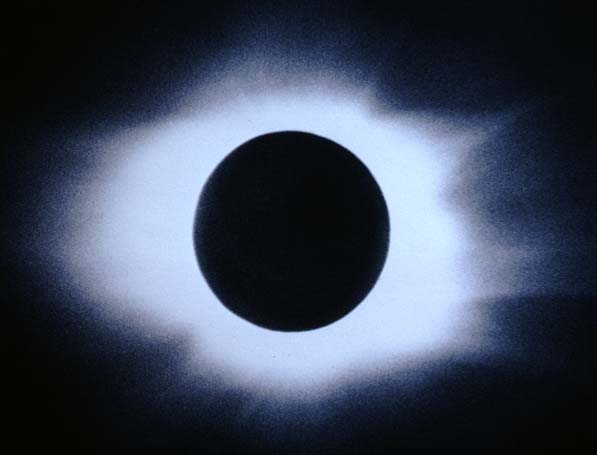
The corona is known to be very hot because it has ions with many electrons removed from the atoms. At high enough temperatures the atoms collide with each other with such energy to eject electrons. This process is called ionization. At very high temperatures, atoms like iron can have 9 to 13 electrons ejected. Nine-times ionized iron is only produced at temperatures of 1.3 million K and 13-times ionized iron means the temperature gets up to 2.3 million K! During strong solar activity, the temperature can reach 3.6 million K and lines from 14-times ionized calcium are seen.
Most of the corona is trapped close to Sun by loops of magnetic field lines. In X-rays, those regions appear bright. Some magnetic field lines do not loop back to the Sun and will appear dark in X-rays. These places are called ``coronal holes''.
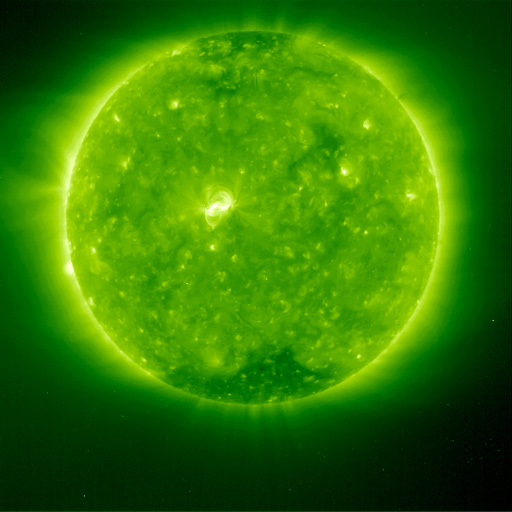
Fast-moving ions can escape the Sun's gravitational attraction. Moving outward at hundreds of kilometers/second, these positive and negative charges travel to the farthest reaches of the solar system. They are called the solar wind. The solar wind particles passing close to a planet with a magnetic field are deflected around the planet. Some are deflected to the planet's magnetic poles. When the charged particles hit the planet's atmosphere, they make the gas particles in the atmosphere produce emission spectra---the aurora borealis in the north and aurora australis in the south (see the aurorae section in the planets chapter). The red aurorae on the Earth are produced by hydrogren emission at the top of the atmosphere. The green aurorae are produced by oxygen emission lower down but still many tens of kilometers above the surface. During solar maximum the increased number and energy of the solar wind particles produce more extensive auroral displays in the Earth's atmosphere---the aurorae can even be seen by those at latitudes near 30ƒ north or south! Usually, aurorae are seen by only those above 50ƒ N latitude (or 50ƒ S latitude for the aurora australis). The effects of the solar wind on the Earth is described more fully in the Space Weather page at Rice University (Houston, TX).
| aurora australis | aurora borealis | chromosphere |
|---|---|---|
| flux | granulation | inverse square law of light brightness |
| solar wind | sunspots |
last update: 04 March 1999
(661) 395-4526
Bakersfield College
Physical Science Dept.
1801 Panorama Drive
Bakersfield, CA 93305-1219